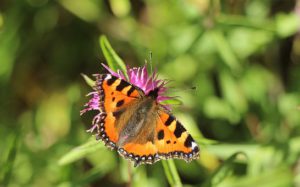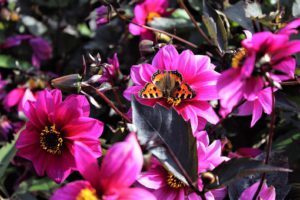The Beauty of the Small Tortoiseshell Butterfly

History of the small tortoiseshell butterfly
The small tortoiseshell butterfly belongs to the family Nymphalidae, this colorful beauty can be found in gardens across Ireland and Britain. The tortoiseshell butterfly is orange to reddish with forewings that have yellow and black margins with the edges of the wings having blue ring spots.
These butterflies congregate in large numbers as they visit gardens in the spring and during the fall months. However, there is a growing concern because of the decline of the tortoiseshell butterflies due to parasites, climate change, pollution, and also drought during the hot summer months.
The tortoiseshell butterfly may produce 2 broods per year, the female lays her eggs on the host plant where once hatched it goes through 4 stages of pupation. The adults feed on nectar and may overwinter by going into hibernation. Below we will go more in detail about the small tortoiseshell butterfly and how you can help save them by providing a home for them in your garden.
Their habitat
The habitat of the small tortoiseshell includes the open countrysides, woodland, grassland, towns, coastal areas, gardens, and farmland.
The life cycle of the small tortoise’s butterfly
After mating the female lays a few hundred green eggs on the underside of the Nettles which are the host plants during the months of April and May. Within a few days, the eggs hatches and the larvas or caterpillars emerge consuming the leaves very quickly because of their huge appetite.
As the caterpillar matures their black bodies develop a line down their sides and dorsal. These lines are pale yellow, the spine that is small and clustered are also yellow, within a months time the caterpillar pupates, during this stage, the caterpillar will find a suitable structure such as walls, stones, fences or other frim structure to spin a pad that is made of silk where it is supported
Some caterpillars may decide to stay near the host (nettles) plant by hanging from this area. Once the caterpillar has secured itself it hangs down. Over the next few days, it turns into a chrysalis after 2 weeks or thereabout a beautiful butterfly emerges to being the cycle over again.
Attracting these garden beauties into your garden and landscape areas
1. To attract small tortoiseshell butterflies to your garden locate an area that gets lots of sunlight.
2. The plants that attract these garden beauties are buddleia, nettles, and flowering plants.
3. Keep your garden plants healthy by giving them the right amount of water and fertilizer to keep them thriving.
4. Filling a shallow dish with sand and water is a good water source and will provide minerals to strengthen their reproductive system.
5. Creating a puddle station will also make your garden more attractive that will also serve as a watering hole and will provide them with minerals. All a puddle station consists of is ensuring that a small part of your garden area remains muddy by keeping the soil moist.
6. Adding a few rocks will provide a place for them to rest and sun.

12 fun facts about the small tortoiseshell butterfly
1. The female tortoiseshell is slightly larger than the male.
2. Eggs are laid in clusters by the female.
3. It’s said as these butterflies get older they become more of a yellowish color.
4. These butterflies can be seen feeding on a wide range of flower plants and shrubs that produce nectar.
5. The tortoiseshell is said to be some of the earliest flying butterflies in the UK.
6. The tortoiseshell butterfly is a common garden butterfly.
7. The adults hibernate during the winter months.
8. The female lays eggs on host plants in batches of 60-100.
9. It’s said that when the butterflies are threatened by predators they swing their bodies from side to side in unison.
10. These butterflies are well known in Britain.
11. They were once found in large numbers in the UK.
12. Both sexes have a wingspan of 50-56mm.
Additional information
1. Don’t use harmful pesticides because these pesticides can be harmful both to the adult and the larva of the small tortoiseshell butterfly.
2. Don’t squash caterpillars because they just might be the larva of these butterflies.
3. When water plants water from the ground level so as not to knock larva from the plant and to water garden plants the proper way.
4. Mulching your garden plants with a 2-3 inch layer of mulch has these benefits.
5. Install garden plants in masse and bunches.
6. The installing of rocks and evergreen plants will help to absorb heat.
7. Introducing beneficial insects in your garden will help in eliminating garden insect pests.
The final word about the small tortoiseshell butterfly
The tortoiseshell butterfly as we mention population is declining, let’s do our part by helping them to find a home by making our gardens inviting to them. These garden beauties deserve our help and to be around for generations to come. The small tortoiseshell butterflies will fill your garden with their amazing colors as you watch them in their natural habitat as their presence fill your gardens with so much activity and excitement.
About the author
Norman loves being in the garden, both at home and for his job....
he is 'Natures Little helper' being outdoors, growing his vegetables and flowers from an early age.
Now having spent over 22 years in the profession he want to give some of his knowledge to others...
his vast array of hints and tips you will find scattered over this site will help you no end growing plants in your garden.

Hi,
Congratulations on taking the time to write such an interesting and informative piece on the Small Tortoiseshell Butterfly a beautiful little thing, I notice that it breeds in Ireland as well as the UK I will look out for it. Once they are born and become adults they feed on nectar, it’s a shame that they are in danger of extinction, its interesting that nettles can attract them into dinny areas in our gardens. Do you have many in your garden? It looks like we must be careful with pesticides in case it kills them off, we must fo all we can to keep these beautiful creatures.
Well done,
Fintan
Hello, butterflies are pretty amazing especially this type that can really make a garden come to life with their presence. We should do all that we can to protect this specie for the next generation. I have not seen butterflies around for the while I guess with the coming of summer we will see them flying about.
Wow, what a beautiful species of butterfly! I’ll bet these are stunning to view while they are flitting across the yard. I find it interesting / didn’t realize that they would hibernate during the winter — fascinating!
I’d love to try to see some in my own garden, but the climate where I live in the Southern USA is not something they’d like. Lately we’ve had some beautiful all yellow butterflies though — no idea what they are but they look like flowers floating through the air!
Wow, that sounds so great, the presence of butterflies can really add to the overall appearance. Just to watch these butterflies in their natural habitat is so amazing. Let’s do what we can to protect this species for the next generation to also enjoy.